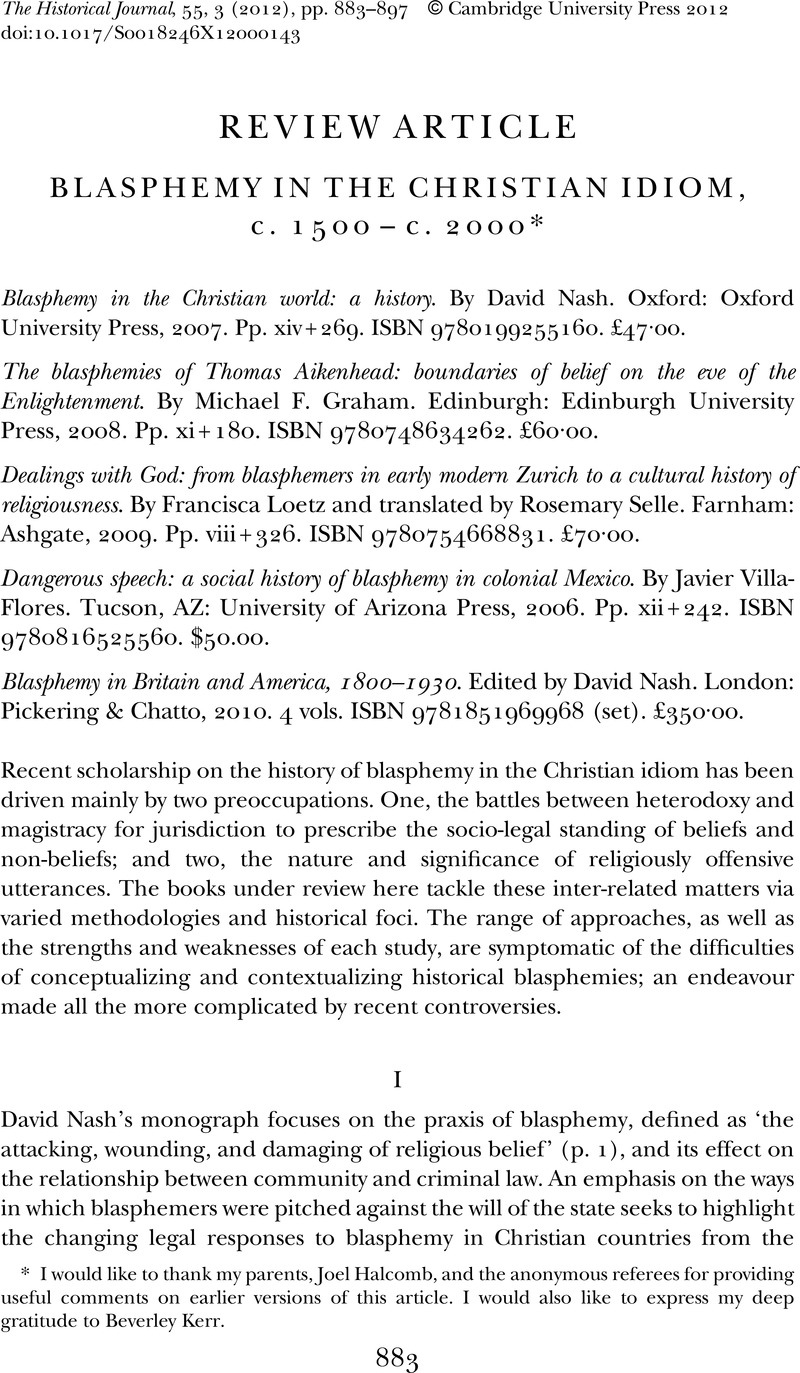No CrossRef data available.
Article contents
BLASPHEMY IN THE CHRISTIAN IDIOM, c. 1500 – c. 2000*
Published online by Cambridge University Press: 03 August 2012
Abstract

- Type
- Review Article
- Information
- Copyright
- Copyright © Cambridge University Press 2012
References
1 For details, see Helmholz, Richard, The spirit of classical canon law (Athens, OH, 1996), pp. 257–83Google Scholar.
2 These include Hill, Christopher, The world turned upside down: radical ideas during the English Revolution (Harmondsworth, 1975)Google Scholar; Helmholz, Richard and Green, Thomas A., eds., Juries, libel, and justice: the role of English juries in seventeenth- and eighteenth-century trials for libel and slander (Los Angeles, CA, 1984)Google Scholar; Davis, J. C., Fear, myth and history: the Ranters and the historians (Cambridge, 1986)Google Scholar; Hunter, Michael and Wootton, David, eds., Atheism from the Reformation to the Enlightenment (Oxford, 1992)CrossRefGoogle Scholar; Lund, Roger D., ed., The margins of orthodoxy: heterodox writing and cultural response, 1660–1750 (Cambridge, 1995)CrossRefGoogle Scholar; Redwood, John, Reason, ridicule, and religion: the age of Enlightenment in England, 1660–1750 (2nd edn, London, 1996)Google Scholar; Hughes, Anne, Gangraena and the struggle for the English Revolution (Oxford, 2004)CrossRefGoogle Scholar; Peters, Kate, Print culture and the early Quakers (Cambridge, 2005)Google Scholar; and Loewenstein, David and Marshall, John, eds., Heresy, literature and politics in early modern English culture (Cambridge, 2006)CrossRefGoogle Scholar.
3 Important studies include Spencer, J. R., ‘Criminal libel – a skeleton in the cupboard’, Criminal Law Review, 24 (1977), pp. 383–94, 465–74Google Scholar; Hamburger, Philip, ‘The development of the law of seditious libel and the control of the press’, Stanford Law Review, 37 (1985), pp. 661–765CrossRefGoogle Scholar; and Harling, Philip, ‘The law of libel and the limits of repression, 1790–1832’, Historical Journal, 44 (2001), pp. 107–34CrossRefGoogle Scholar. The articles by Spencer and Hamburger are not cited by Nash.
4 Celsus, On the true doctrine: a discourse against the Christians, trans. R. Joseph Hoffmann (New York, NY, 1987), p. 57.
5 For challenges to the clichéd view, see Porter, Roy, ed., Rewriting the self: histories from the Renaissance to the present (London, 1997)Google Scholar; Shepard, Alexandra and Withington, Phil, eds.,Communities in early modern England: networks, place, rhetoric (Manchester, 2000)Google Scholar; and Martin, John Jeffries, Myths of Renaissance individualism (Basingstoke, 2004)CrossRefGoogle Scholar.
6 The criminal justice and immigration act, 2008, ch. 4, part v, § 79: www.legislation.gov.uk/ukpga/2008/4 (accessed 20 Sept. 2011).
7 Herrup, Cynthia, A house in gross disorder: sex, law, and the 2nd Earl of Castlehaven (Oxford, 1999), p. 6Google Scholar.
8 Michael Hunter, ‘“Aikenhead the atheist”: the context and consequences of articulate irreligion in the late seventeenth century’, in Hunter and Wootton, eds., Atheism from the Reformation to the Enlightenment, pp. 221–54.
9 It is rarely acknowledged that, on 29 Jan. 1678 and 14 Dec. 1680, the House of Lords considered a Bill for the ‘punishing of Atheism and Blasphemy’ which attempted to reinstate the death penalty for those who denied or reproached God, or any of the persons of the Trinity. See the parliamentary archives HL/ PO/ JO/ 10/1/464, HL/ PO/JO/10/1/397/343.
10 Conley, Carolyn A., The unwritten law: criminal justice in Victorian Kent (New York, NY, 1991)Google Scholar.
11 Shelley Burtt, ‘The societies for the reformation of manners: between John Locke and the Devil in Augustan England’, in Lund, ed., The margins of orthodoxy, pp. 149–69.
12 Walsham, Alexandra, Charitable hatred: tolerance and intolerance in England, 1500–1700 (Manchester, 2006)Google Scholar.
13 Hughes, Gangraena and the struggle for the English Revolution.
14 Surprising omissions include Hunter, Michael, ‘The problem of “atheism” in early modern England’, Transactions of the Royal Historical Society, 5th ser., 35 (1985), pp. 135–57Google Scholar; Flynn, Maureen, ‘Blasphemy and the play of anger in sixteenth-century Spain’, Past and Present, 149 (1995), pp. 29–56CrossRefGoogle Scholar; and Spurr, John, ‘A profane history of early modern oaths’, Transactions of the Royal Historical Society, 6th ser., 11 (2001), pp. 37–63CrossRefGoogle Scholar.
15 Cabantous, Alain, Blasphemy: impious speech in the West from the seventeenth to the nineteenth century, trans. Eric Rauth (New York, NY, 2002)Google Scholar.
16 The invocation of the demise of Francis Spira (d. 1548) forms part of a complex phenomenon in the history of Christianity. The tale was popularized by, amongst others, Richard Sault (d. 1702), whose pamphlet The second Spira was printed in London, England, and Boston, Massachusetts, well into the late eighteenth century. For further details, see: MacDonald, Michael, ‘The fearefull estate of Francis Spira: narrative, identity, and emotion in early modern England’, Journal of British History, 31 (1992), pp. 32–61Google Scholar; and Overell, M. A., ‘Recantation and retribution: “remembering Francis Spira”, 1548–1638’, Studies in Church History, 40 (2004), pp. 159–68CrossRefGoogle Scholar.
17 The ESTC cites Hill as author of an anonymous pamphlet entitled An important case argued (6th edn, 1790), which (in Nash, i, p. 28) is stated as being written by the same author as Socinian blasphemy exposed (2nd edn, 1791).
18 For an introduction, see Stafford, William, ‘Shall we take the linguistic turn? British radicalism in the era of the French Revolution’ (a review article), Historical Journal, 43 (2000), pp. 583–94CrossRefGoogle Scholar.
19 A précis of the collection on the publisher's website states that the ‘sources are arranged to represent both sides of the debate, giving voice to the accused and the accusor [sic]’. See www.pickeringchatto.com/major_works/blasphemy_in_britain_and_america_1800_1930 (accessed 1 Aug. 2011).
20 Further important studies hitherto unmentioned include Kamensky, Jane, Governing the tongue: the politics of speech in early New England (Oxford, 1997)Google Scholar; Marsh, Joss, Word crimes: blasphemy, culture, and literature in nineteenth-century England (Chicago, IL, 1998)Google Scholar; Horodowich, Elizabeth, Language and statecraft in early modern Venice (Cambridge, 2008)Google Scholar; and my own ‘Blasphemy in England, c. 1660–1730’ (unpublished Ph.D. thesis, Cambridge, 2009).


